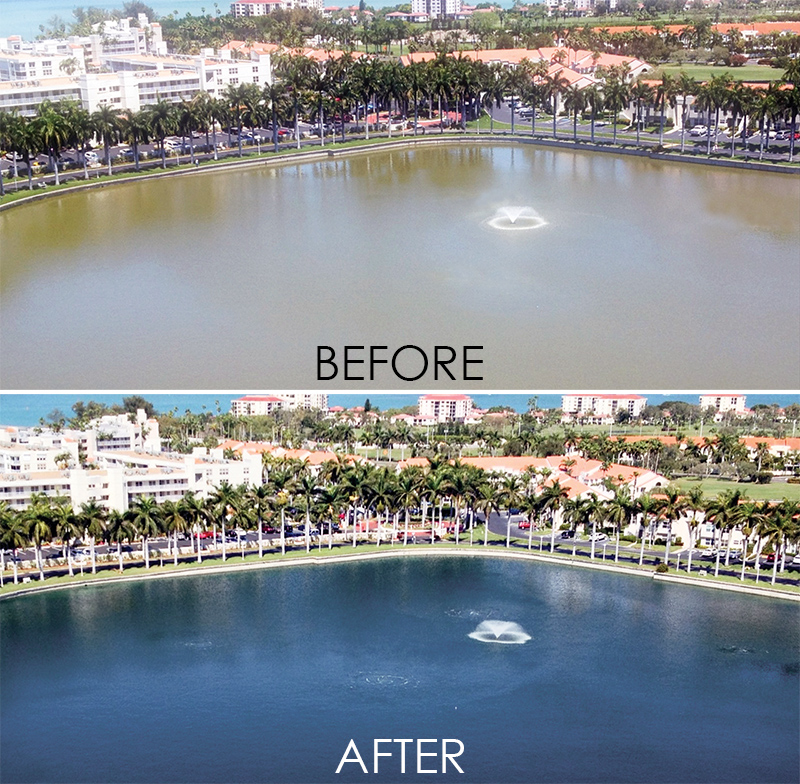Bahia Del Mar Lake Restoration Case Study
Bahia Del Mar is a 14 acre lake located in St. Petersburg, FL. The Home Owners Association contacted a local lake management company to request assistance with multiple lake issues. The lake experienced foul odors, ongoing fish kills and recurring algae blooms. Together, these symptoms pointed to the need for a full lake restoration plan including aeration.
Testing showed the lake was severely stratified, with high biological oxygen demand and very low oxygen levels. The lack of oxygen increased organic material in bottom waters, leading to high nutrient levels and concentrations of hydrogen sulfide causing a rotten egg odor.
Assessing the Lakes Problems
Field and Lab Testing
Both field and lab tests where used to determine the existing chemical and biological conditions of the lake. Tests included levels of oxygen, redox, conductivity, pH, hydrogen sulfide, biochemical oxygen demand, salinity, turbidity, phosphorus, nitrogen and chlorophyll a.
Results showed that the lake was unsuitable for fish and other aquatic organisms; and posed a health risk to residents due to the intense noxious fumes being emitted from the lake. The main problems and the underlying causes identified were:
Intense odor causes
Hydrogen sulfide (the source of the “rotten egg” odor) permeated the lake and surrounding area due to:
-
- Stratification – the water never mixed enough to get oxygen to the lower levels where it was needed
- Large amounts of organic sediments feeding bacteria. As bacteria broke down organic matter, the available oxygen in the water was completely depleted and, without oxygen, bacteria produce hydrogen sulfide
Fish kills
Major fish kills that were likely due to rapid mixing of stratified layers by an existing aeration system that was undersized and installed only in the shallower areas. This undersized system was only strong enough to churn up water from the bottom of the lake without properly mixing and adding oxygen to the entire water column. This rapid mixing of bottom layer waters into the upper water levels depleted all the oxygen in the surface water and brought up high levels of hydrogen sulfide, methane and ammonia from the bottom waters up to the surface causing the death of fish, crabs, shrimp, snails and some birds in the lake.
Algae blooms
The breakdown of large amounts of organic matter in the lower water column over time caused the buildup of high concentrations of nutrients, primarily phosphorus and nitrogen. These high nutrient levels fed algal growth in the lake, which made the water look like “pea soup”.
Bathymetric Mapping
The lake management company had been told that the lake was only 18’ at it deepest point. To confirm this, bathymetric mapping was conducted to determine accurate depths throughout the lake, the total water volume and the location of vegetation in the lake. Contrary to what everyone thought, mapping showed areas within the lake that were actually over 50’ deep. This information showed why the existing aeration was not effective and allowed us to determine exactly how much aeration was needed to circulate the entire water body each day; and to identify the best locations in the lake for placement of the aeration.
Lake Restoration Using Aeration and Alum Together
 The lake did not support fish and other aquatic organisms, and it posed a health risk to residents. To correct this, a two-pronged approach brought the lake back to a healthy state quickly.
The lake did not support fish and other aquatic organisms, and it posed a health risk to residents. To correct this, a two-pronged approach brought the lake back to a healthy state quickly.
Lake Aeration
According to a bathymetric map the total lake volume is far higher than their existing aeration could handle. With this in mind, two Vertex Aeration Systems, an LL 4XL5 Aeration System and a HF 4XL5 Aeration System with sound kits were installed in April, 2012 to provide effective turnover rates.
Alum application
Two treatments of Alum at a rate of 60ppm were applied to quickly improve water clarity and reduce water phosphorus levels.
Results:
The lake restoration was complete: Oxygen at bottom of the lake went from 0 mg/L to 8 mg/L
- Oxygen at bottom of the lake went from 0 mg/L to 8 mg/L
- 100% reduction in hydrogen sulfide in the water column – “Rotten Egg” Odor eliminated
- 99% reduction at the bottom of the lake of BOD, Phosphate and Nitrogen Ammonia
- 92% reduction in Turbidity
- 72% reduction in Algae
For more detailed information, download the full case study.
Lake showing symptoms of low oxygen? Get expert help now.
Vertex Aquatic Solutions, founded in 1977, is the professionals’ choice for research based scientific consulting services, aeration systems, floating fountains, bubble curtains and biological products to enhance water quality in lakes, ponds, canals, marinas and reservoirs. As respected leaders in the lake management industry the Vertex team of aquatic biologists, limnologists, fisheries scientists and engineers work together to deliver science-based, environmentally sound solutions to complex waterbody issues. Our products and services are delivered through an international network of qualified, experienced waterbody professionals who provide local support, service and pond management expertise to customers.
← Previous